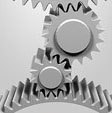| Lubrication of Gears The purpose of lubricating gears is as follows: 1. Promote sliding between teeth to reduce the coefficient of friction. 2. Limit the temperature rise caused by rolling and sliding friction. To avoid difficulties such as tooth wear and premature failure, the correct lubricant must be chosen. Methods of Lubrication There are three gear lubrication methods in general use: 1. Grease lubrication. Grease lubrication is suitable for any gear system that is open or enclosed, so long as it runs at low speed. There are three major points regarding grease: 1.1 Choosing a lubricant with suitable viscosity. Lubricant with good fluidity is especially effective in an enclosed system. 1.2 Not suitable for use under high load and continuous operation. The cooling effect of grease is not as good as lubricating oil. So it may become a problem with temperature rise under high load and continuous operating conditions. 1.3 Proper quantity of grease. There must be sufficient grease to do the job. However, too much grease can be harmful, particularly in an enclosed system. Excess grease will cause agitation, viscous drag and result in power loss. 2 Splash Lubrication(oil bath method) Splash lubrication is used with an enclosed system. The rotating gears splash lubricant onto the gear system and bearings. It needs at least 3 m/s tangential speed to be effective. However, splash lubrication has several problems, two of them being oil level and temperature limitation. 2.1 Oil level. There will be excessive agitation loss if the oil level is too high. On the other hand, there will not be effective lubrication or ability to cool the gears if the level is too low. Also, the oil level during operation must be monitored, as contrasted with the static level, in that the oil level will drop when the gears are in motion. This problem may be countered by raising the static level of lubricant or installing an oil pan. 2.2 Temperature limitation. The temperature of a gear system may rise because of friction loss due to gears, bearings and lubricant agitation. Rising temperature may cause one or more of the following - Lower viscosity of lubricant. - Accelerated degradation of lubricant. - Deformation of housing, gears and shafts. - Decreased backlash. New high-performance lubricants can withstand up to 80 to 90°C. This temperature can be regarded as the limit. If the lubricant's temperature is expected to exceed this limit, cooling fins should be added to the gear box, or a cooling fan incorporated into the system. 3 Forced-Circulation Lubrication Forced-circulation lubrication applies lubricant to the contact portion of the teeth by means of an oil pump. There are drop, spray and oil mist methods of application. 3.1 Drop method: An oil pump is used to suck-up the lubricant and then directly drop it on the contact portion of the gears via a delivery pipe. 3.2. Spray method: An oil pump is used to spray the lubricant directly on the contact area of the gears. 3.3 Oil mist method: Lubricant is mixed with compressed air to form an oil mist that is sprayed against the contact region of the gears. It is especially suitable for high-speed gearing. Oil tank, pump, filter, piping and other devices are needed in the forced-lubrication system. Therefore, it is used only for special high-speed or large gear box applications. By filtering and cooling the circulating lubricant, the right viscosity and cleanliness can be maintained. This is considered to be the best way to lubricate gears. Properties of lubricate 1 Lubricant should maintain a proper viscosity to form a stable oil film at the specified temperature and speed of operation. 2 Lubricant should have the property to prevent the scoring failure of tooth surface while under high-pressure of load. 3 A good lubricant should not oxidize easily and must perform in moist and high-temperature environment for long duration. 4 The lubricant should have the property of isolating moisture and water from lubricant. If the lubricant foams under agitation, it will not provide a good oil film. Antifoam property is a vital requirement. Lubrication should be neutral and stable to prevent corrosion from rust that may mix into the oil. Viscosity of Lubricant The correct viscosity is the most important consideration in choosing a proper lubricant of gears. There is no single best lubricant and method. Choice depends upon tangential speed (m/s) and rotating speed (rpm). At low speed, grease lubrication is a good choice. For medium and high speeds, splash lubrication and forced circulation lubrication are more appropriate, but there are exceptions. Sometimes, for maintenance reasons, a grease lubricant is used even with high speed. |
|
Remember to bookmark this web site for your future convenience! |
